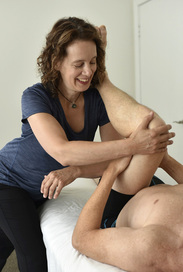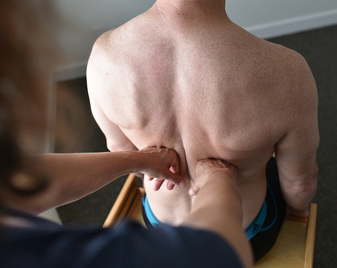Information about Rolfing® Structural Integration Sessions
The Rolfing® Structural Integration 10-Series
You've had a lifetime to become who you are. This classic series, developed by Ida Rolf, is structured to allow for change to happen in a progressive and systematic way in order for your body to adapt and integrate. Taken as a whole, the series is more profound and lasting than simply receiving isolated sessions. Each session has unique goals and areas to be addressed, but this is merely a map; it is not the terrain. The work will vary depending upon your unique relationship to gravity, lines of tension, movement patterns and body awareness.
- 1-3 • The Sleeve Sessions — opening and organizing the superficial fascia to allow space for the core to lengthen. These sessions help to expand the breath throughout the body and find a sense of dynamic support.
- 4-7 • The Core Sessions — working in the deep layers to open and balance the core around the line of gravity. Here we focus on the mid-line and structures close to the spine to provide length and deep support.
- 8-10 • The Integrative Sessions — building on the work from previous sessions and enhancing integration with movement and perceptual awareness to allow you to embody your line in lasting, sustainable way.
Rolfing 3-series
Sessions 1-3 can be received as a stand-alone series. It's a good time to assess if the work is appropriate for you at this time. If you choose to proceed after 3, it is recommended to finish the 10-series.
Single Rolfing Sessions
Individual sessions can be scheduled to do more "fix-it" style work, and many clients then choose to do the series after they've experienced the benefits of the work.
|
Session Length/Frequency
My sessions run approximately 90 minutes in length. Some scheduling recommendations: Sessions 1-3: once a week or once every other week. If desired, you can take a little break before starting 4. Sessions 4-7: I also recommend once a week or once every other week. You can take another break before 7-10. The final 3 sessions can be slightly more spread out to allow more opportunity for your body to adapt and integrate.
Frequently Asked Questions
What happens after the 10-series?
Your body will continue to change after you finish the series. You may choose to come back and do some further work, but it is helpful to leave some time in between. If you would like to continue receiving bodywork during this time, I also offer Massage Therapy and Zero Balancing® sessions to help maintain and support your body.
What do I wear to a session?For women, a bra and underwear or 2-piece swimsuit
For men, briefs (not boxers as they don't stretch) This attire allows me to assess your alignment and movement as well as access the areas I need to work on. In addition, it enables you to easily transition from the massage table to standing or seated bench work. For comfort, you may always elect to be draped with a blanket while on the massage table. |
What does it feel like?
This work is a partnership, and change occurs at the place where my pressure meets your awareness. I may have you focus your attention under my hands, take a breath or make a small movement. As your body becomes more accustomed to participating, it will begin to feel like you can use my hands as tools to get to the stuck places. And that feels pretty good!
Rolfing still has a mythical reputation for being painful. While there is a wide spectrum of touch in the Rolfing community, I believe research on fascia, the nervous system and influences from somatic disciplines have informed how the work is currently taught and practiced. As Ida Rolf, herself said, "It's not how deep you go. It's how you go deep." My philosophy is that the appropriate sensation ranges from "it feels good" to "it hurts so good."
Rolfing still has a mythical reputation for being painful. While there is a wide spectrum of touch in the Rolfing community, I believe research on fascia, the nervous system and influences from somatic disciplines have informed how the work is currently taught and practiced. As Ida Rolf, herself said, "It's not how deep you go. It's how you go deep." My philosophy is that the appropriate sensation ranges from "it feels good" to "it hurts so good."
What can I do after a session?
Most people leave a session feeling relaxed and energized. The framework of the session always includes some integration at the end, so you will leave feeling grounded and ready to go out in the world. It's nice to be able to take a walk outside to feel how your body moves and notice the changes from the session. One thing to be aware of: you may have more energy and feel that you can do more. Because of that, some people tend to overdo their workouts, so be mindful of how you're increasing your activity.
Is Rolfing for everyone?
The short answer is "no," and I would be happy to talk with you further to determine if Rolfing or another form of bodywork would be appropriate for you.
Free in-person Rolfing® Structural Integration Consultation
Often, the best way to determine if Rolfing is for you is to schedule an in-person consultation. This is a free half-hour session where I'm able to look at your structure, perhaps do a little hands-on work, and discuss what benefits you'd hope to receive from the series.
Copyright © 2016 Embodied Line All rights reserved. **Photos by Stephen Murphy
Proudly powered by Weebly


